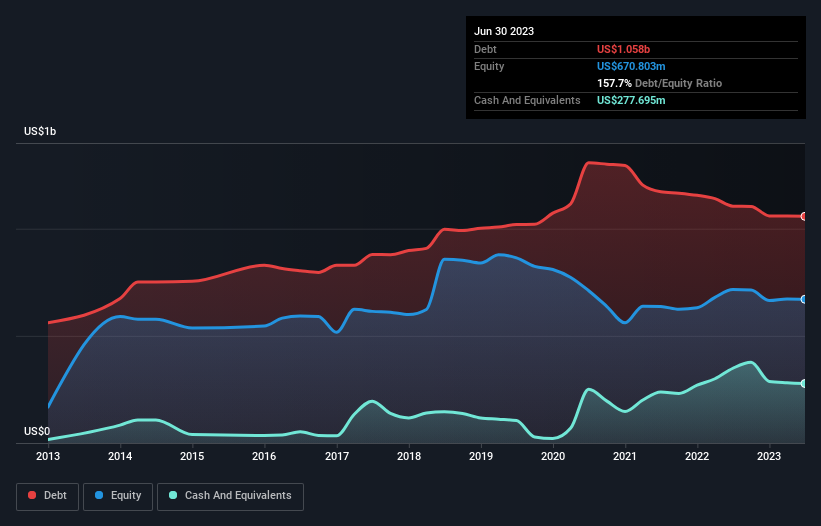- United States
- /
- Hospitality
- /
- NasdaqGS:PLYA
Here's Why Playa Hotels & Resorts (NASDAQ:PLYA) Can Manage Its Debt Responsibly

David Iben put it well when he said, 'Volatility is not a risk we care about. What we care about is avoiding the permanent loss of capital.' When we think about how risky a company is, we always like to look at its use of debt, since debt overload can lead to ruin. We note that Playa Hotels & Resorts N.V. (NASDAQ:PLYA) does have debt on its balance sheet. But the real question is whether this debt is making the company risky.
Why Does Debt Bring Risk?
Debt assists a business until the business has trouble paying it off, either with new capital or with free cash flow. Ultimately, if the company can't fulfill its legal obligations to repay debt, shareholders could walk away with nothing. However, a more frequent (but still costly) occurrence is where a company must issue shares at bargain-basement prices, permanently diluting shareholders, just to shore up its balance sheet. By replacing dilution, though, debt can be an extremely good tool for businesses that need capital to invest in growth at high rates of return. The first step when considering a company's debt levels is to consider its cash and debt together.
View our latest analysis for Playa Hotels & Resorts
What Is Playa Hotels & Resorts's Net Debt?
As you can see below, Playa Hotels & Resorts had US$1.06b of debt at June 2023, down from US$1.11b a year prior. However, it also had US$277.7m in cash, and so its net debt is US$780.1m.

A Look At Playa Hotels & Resorts' Liabilities
Zooming in on the latest balance sheet data, we can see that Playa Hotels & Resorts had liabilities of US$131.6m due within 12 months and liabilities of US$1.24b due beyond that. Offsetting this, it had US$277.7m in cash and US$91.3m in receivables that were due within 12 months. So it has liabilities totalling US$998.4m more than its cash and near-term receivables, combined.
This is a mountain of leverage relative to its market capitalization of US$1.03b. This suggests shareholders would be heavily diluted if the company needed to shore up its balance sheet in a hurry.
In order to size up a company's debt relative to its earnings, we calculate its net debt divided by its earnings before interest, tax, depreciation, and amortization (EBITDA) and its earnings before interest and tax (EBIT) divided by its interest expense (its interest cover). This way, we consider both the absolute quantum of the debt, as well as the interest rates paid on it.
While Playa Hotels & Resorts's debt to EBITDA ratio (3.4) suggests that it uses some debt, its interest cover is very weak, at 1.5, suggesting high leverage. So shareholders should probably be aware that interest expenses appear to have really impacted the business lately. On a lighter note, we note that Playa Hotels & Resorts grew its EBIT by 24% in the last year. If sustained, this growth should make that debt evaporate like a scarce drinking water during an unnaturally hot summer. There's no doubt that we learn most about debt from the balance sheet. But it is future earnings, more than anything, that will determine Playa Hotels & Resorts's ability to maintain a healthy balance sheet going forward. So if you want to see what the professionals think, you might find this free report on analyst profit forecasts to be interesting.
Finally, a company can only pay off debt with cold hard cash, not accounting profits. So we clearly need to look at whether that EBIT is leading to corresponding free cash flow. Over the most recent two years, Playa Hotels & Resorts recorded free cash flow worth 78% of its EBIT, which is around normal, given free cash flow excludes interest and tax. This free cash flow puts the company in a good position to pay down debt, when appropriate.
Our View
Playa Hotels & Resorts's conversion of EBIT to free cash flow was a real positive on this analysis, as was its EBIT growth rate. In contrast, our confidence was undermined by its apparent struggle to cover its interest expense with its EBIT. Looking at all this data makes us feel a little cautious about Playa Hotels & Resorts's debt levels. While debt does have its upside in higher potential returns, we think shareholders should definitely consider how debt levels might make the stock more risky. The balance sheet is clearly the area to focus on when you are analysing debt. However, not all investment risk resides within the balance sheet - far from it. Be aware that Playa Hotels & Resorts is showing 3 warning signs in our investment analysis , and 1 of those shouldn't be ignored...
At the end of the day, it's often better to focus on companies that are free from net debt. You can access our special list of such companies (all with a track record of profit growth). It's free.
New: Manage All Your Stock Portfolios in One Place
We've created the ultimate portfolio companion for stock investors, and it's free.
• Connect an unlimited number of Portfolios and see your total in one currency
• Be alerted to new Warning Signs or Risks via email or mobile
• Track the Fair Value of your stocks
Have feedback on this article? Concerned about the content? Get in touch with us directly. Alternatively, email editorial-team (at) simplywallst.com.
This article by Simply Wall St is general in nature. We provide commentary based on historical data and analyst forecasts only using an unbiased methodology and our articles are not intended to be financial advice. It does not constitute a recommendation to buy or sell any stock, and does not take account of your objectives, or your financial situation. We aim to bring you long-term focused analysis driven by fundamental data. Note that our analysis may not factor in the latest price-sensitive company announcements or qualitative material. Simply Wall St has no position in any stocks mentioned.
About NasdaqGS:PLYA
Playa Hotels & Resorts
Through its subsidiaries, owns, develops, and operates resorts in prime beachfront locations in Mexico and the Caribbean.
Slightly overvalued with limited growth.
Similar Companies
Market Insights
Community Narratives



